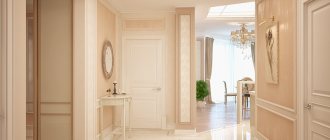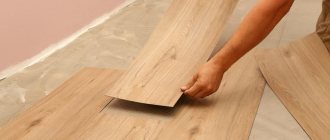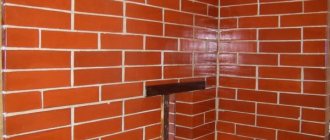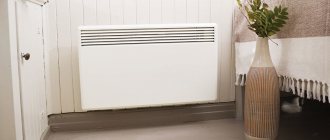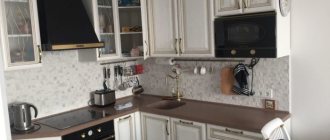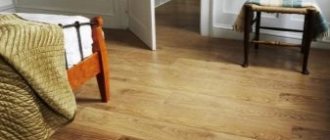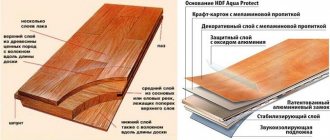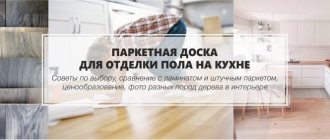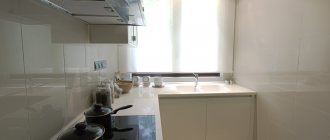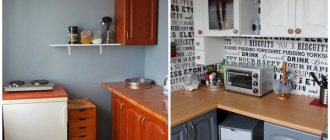What flooring to choose for the kitchen - this question arises for all homeowners who decide to carry out renovation work in this room. It must be said that the task of choosing is by no means an easy one, since today the assortment of construction stores offers such an abundance of different materials that, without information about them, you can easily get lost. Therefore, it makes sense to further consider the most popular floor coverings for the kitchen and take a closer look at their characteristics.
Flooring for the kitchen what to choose
Well, first you need to decide on the requirements that the floor covering in the kitchen must meet.
First, consider the initial data of the kitchen
Before you think about what is best to put on the floor in the kitchen, you need to think about where exactly the room is located:
1. If we are talking about a high-rise building and the middle floor, then almost any floor will be warm enough and there is no point in worrying too much about insulation. 2. But if you live on the ground floor or in a private house, then the conversation is different, since in winter, without special heating, the floor can be simply icy.
The initial humidity of the room also matters, which, again, depends on the location. Particularly wet kitchens occur on the first floors and in houses without a basement. Having laid a wooden floor in such a kitchen, for example, you should not expect that it will last a long time and will not need sanding.
But let's take things in order.
Main characteristics of popular floor coverings
Now, knowing all the qualities that a kitchen flooring should have, we can consider the advantages of the most popular ones.
Ceramic tile
Ceramic tiles today are one of the most popular floor coverings for rooms such as the bathroom, hallway and kitchen. If this material is laid in the kitchen of a private house or above an unheated room, then a “warm floor” system is most often installed underneath it, since this material itself is cold, but has high thermal conductivity.
Ceramic tiles have been and remain the leader in popularity among other kitchen floor coverings
If you decide to use ceramic tiles for your kitchen floor, you should familiarize yourself with some of its basic characteristics. They will help you decide on the right choice of this material.
- Wear resistance
The wear resistance of ceramic tiles is determined by five categories, and depends on the degree of its selectability. This indicator has the abbreviation PEI:
- PEI I - tiles bearing this marking are intended exclusively for wall decoration.
- PEI II - a similar category of material is used for the floors of bedrooms and bathrooms. It is recommended to walk on this surface only in soft-soled shoes or barefoot.
- PEI III - material of this category can be laid in any room except the hallway, since it does not have sufficient resistance to abrasive wear.
- PEI IV - tiles with this marking are used to cover floors in public buildings, as they have a high level of wear resistance. Therefore, this material option is well suited for the flooring of kitchens and hallways.
- PEI V - this category has the highest degree of wear resistance, and is usually purchased for installation in places with high traffic levels, for example, for shops. Therefore, this option is also suitable for the hallway and kitchen. True, the feasibility seems questionable: the strength characteristics of such a coating are excessive for apartment conditions, and the price is significantly higher.
Based on the above arguments, we can conclude that the best option for a kitchen floor would be tiles with a wear resistance category of PEI IV, or, in extreme cases, PEI III.
- Chemical resistance
The resistance of ceramic tiles to chemical influences is indicated by the letter symbols: AA, A, B, C and D. The material designated by the letters A and AA has maximum resistance to aggressive chemicals. It is these categories, as well as tile B, that are well suited for installation in kitchen areas.
Pay attention to the category of tiles for moisture absorption
- Moisture resistance
The level of moisture resistance depends on the tile manufacturing method - pressing (B) and extrusion (A). Tiles made by pressing have a high density and strength, while material produced using extrusion technology has a more porous structure.
Ceramic finishing material is divided into three categories, each of which has an additional letter designation, and is characterized by its own moisture absorption parameters, in% by weight:
— AI and VI are the most moisture-resistant ceramic tiles. The moisture absorption of its surface is only 3%.
- AIIa and BIIa - these categories absorb from 6% to 10% of moisture from the total mass and have good frost resistance;
— AIII and BIII are the least moisture-resistant tiles, since their moisture absorption exceeds 10%.
Tiles with the number I in the category designation are intended for tiling bathrooms and swimming pools. If desired, it can also be used in the kitchen.
Category II is often used for external finishing work.
Category III is used for finishing floors and walls exclusively indoors with normal humidity levels. For the kitchen this is far from the best option.
The level of moisture resistance directly affects the cost of the tile - the higher the category, the higher the price set for it.
- Tile surface
The surface of the tile can be glossy, matte, embossed, rough and polished. The best option for the kitchen would be embossed, rough, and, in extreme cases, matte tiles - these options are practically non-slippery and safe for walking even on a slightly damp surface. However, you should not choose tiles with too deep a relief, as dirty deposits will become clogged in its recesses, which will be difficult to clean.
The slipperiness of ceramic tiles is indicated by the coefficient of friction and special attention should be paid to this parameter, since the safety of being in the kitchen depends on it. The friction coefficient is divided into 4 categories:
Kitchen-safe rough tiles
— The safest tile has a digital designation of 0.75.
— Conditionally safe material is designated 0.39÷0.74.
— Dangerous, that is, quite slippery, has a friction coefficient from 0.22 to 0.39.
— Very slippery, its coefficient is no less than 0.19. Such tiles cannot be laid on the floor.
From these parameters we can conclude that rough or embossed tiles have the maximum safe coefficient of friction, while smooth and glazed tiles have a lower value and are not suitable for floor coverings.
- Grade of ceramic tiles
In addition to the above characteristics, you should pay attention to the type of tile - this parameter indicates the amount of possible defects in each of the packages - mismatch in size, linearity of material, etc. There are three types of ceramic, each of them is usually marked with its own color:
— I grade (red) — has no more than 5% conditionally defective products;
— II grade (blue) — has up to 20% defective material;
- III grade (green) - this is the lowest quality and inexpensive product.
There are other characteristics, and there are quite a lot of them, but above are the main ones that you need to pay special attention to. In order not to get confused in the parameters when going to the store, you should write down the necessary data and, based on them, select the desired sample.
- Decorativeness
A little needs to be said about the decorative qualities of ceramic tiles, since the overall appearance of the kitchen interior will depend on this.
Nowadays, the commercial assortment offers a very wide variety of finishing floor tiles of various colors and patterns, which can imitate natural materials, or simply be decorated with interesting patterns and ornaments.
A well-chosen combination of several types of ceramic tiles looks very original.
The tiles can have a raised pattern, giving the floor a richer “carpet” look. When choosing a finishing material according to this criterion, it is necessary to take into account its harmony in color, texture and relief with the design of the rest of the interior.
Mosaic laying of ceramic tiles on the floor can visually expand a cramped space
It is important to choose the right tiles in shape and size, since this criterion will determine whether the kitchen space will visually expand or whether it will look smaller than it actually is. Today you can find material on sale in a wide variety of configurations and sizes - tiles can have geometrically regular and patterned shapes, so if you wish, you can bring any ideas and design ideas to life. In addition to the tile itself, it is always possible to purchase embossed borders or “carpet” elements to go with it.
Linoleum for the kitchen
One of the most practiced solutions is to cover the kitchen floor with high-quality linoleum
. Despite the abundance of new materials, linoleum can still be called the most popular floor covering not only for the kitchen, but also for any room in the apartment. The main thing is to choose the one that is ideal for a particular room.
Types of linoleum
In flooring stores you can find two main types of linoleum - natural and made from synthetic raw materials. Each of them is suitable for different rooms, and has its own advantages and disadvantages.
liquid linoleum
Synthetic based linoleum
The most popular is linoleum made from synthetic raw materials, since it is affordable even for a family with an average income. It is quite durable - high-quality artificial linoleum, subject to the rules of operation and care, will last 12–15 years.
Artificial linoleum is made from various materials, but for use in residential buildings, the material most often purchased is polyvinyl chloride, which, according to experts, is the safest for humans, with the exception of some cases of individual intolerance.
Scheme of the structure of multilayer PVC linoleum
Linoleum intended for residential premises is a multilayer structure:
- The bottom layer is the base of the material.
- Elastic backing made of foamed polyvinyl chloride.
- Reinforcing fiberglass layer that gives the material strength.
- Another layer of polyvinyl chloride, which has a smaller thickness.
- A layer consisting of a decorative film with a pattern applied to it.
- A transparent layer that increases the wear resistance of the material.
- Top protective film.
Multilayer linoleum is referred to as heterogeneous.
If the material consists of one layer (not counting the upper protective film), then it is called homogeneous. Such material can be either very thin or have a thickness of 10–15 mm. Homogeneous linoleum is a high-quality material, but it does not have a variety of decorative textures - it is usually monochrome, sometimes “decorated” with splashes of color.
Homogeneous linoleum, as a rule, is monochromatic, only with splashes of color.
The most common PVC linoleum has almost all of the above requirements for kitchen flooring:
- The material is water resistant.
- Easy to clean.
- Resistant to abrasion and mechanical stress.
- It is quite durable - its service life is on average 12÷15 years.
- Affordable.
- It is easy to lay linoleum yourself, as it is quite simple to install.
- This flooring is available in a very wide range of design solutions. Linoleum can imitate parquet, ceramic tiles, cork or plank flooring, as well as many other ornamental or clear geometric patterns.
- Some relief patterns are not only decorative, but also an anti-slip element of the linoleum covering.
Artificial linoleum comes in three classes - commercial, semi-commercial and household. For flooring in apartment premises, it is necessary to choose only the household version of the material, which is classified as 21, 22 and 23 classes and has a thickness of 3÷5 mm.
The number “2” in front indicates that the material is intended for living space, and the second number shows the resistance of linoleum to stress. For example, “1” is low resistance, and “3” is the highest abrasion resistance for a household version of such a floor covering.
Classification table for household linoleum.
| Linoleum class | Symbols of class placed on packaging | Permissible load level | Load intensity | Optimal places to use the material |
| 21 | short | Rooms with low traffic intensity or areas that are rarely visited. | Storage room and bedroom. | |
| 22 | average | Premises with moderate intensity of human movement. | Living room, dining room, office and kitchen. | |
| 23 | high | Premises with traditionally high intensity of people movement | Kitchen and hallway. |
From this table it can be seen that for the kitchen, in principle, 22 is suitable, but class 23 flooring would be even better.
Semi-commercial and commercial classes are more durable, but they have a higher content of components that are not harmless to humans, and their use in domestic conditions is not recommended.
Linoleum PVC tiles
Linoleum is produced not only in the usual rolls, but also in other forms that are easier to install.
laminate for kitchen
Laying flexible linoleum PVC tiles
You can purchase PVC linoleum in square or rectangular tiles - these materials can imitate ceramic coating, parquet or laminate. Installing such tiles is quite simple, since they usually have an adhesive layer on the back side, covered with a protective backing. However, in order for the installation process to be easy and the resulting coating to be of high quality, the base under it must be almost perfectly flat and smooth.
Linoleum in this form of release has its own advantages and disadvantages, which you also need to know about before choosing it.
The positive qualities of PVC tiles include both the ease of laying the material and the ability to replace areas damaged during operation. There is no need to remove the entire coating or cut out a separate area of it and look for a suitable replacement. To dismantle the area that requires replacement, you simply need to remove the damaged tiles and fix new ones in their place. Based on this circumstance, it is recommended that when purchasing a covering, purchase it with a reserve, that is, take 5-10 tiles more than is actually required for the kitchen floor area. They are inexpensive, and such a reserve will not “hit your pocket.”
One of the positive qualities is that all kinds of designs and compositions can be created from PVC tiles of various colors, so the interior of the kitchen can be made absolutely exclusive. A wide range of colors of monochromatic material, as well as those with ornamental patterns, allows you to choose the desired decorative option for a specific interior.
An obvious drawback of tiled linoleum is that there are too many seams, which is not very good for covering a kitchen floor, since the humidity in this room is high due to fumes of various origins - this can lead to gradual separation of the material from the base. If you still want to use tiled linoleum to cover the kitchen floor, then you need to prepare the base for it very well. It must be perfectly flat and well-primed.
Natural linoleum (marmoleum)
Natural linoleum, also known as marmoleum, is made from cork and lime powder, linseed oil and wood flour with the addition of natural coloring pigments to the overall mixture. The basis for this type of material is flax or jute fibers or non-woven materials.
Natural linoleum (marmoleum) is designed for many years of use
The technological principles for the production of this natural floor covering have not changed for many decades - only the designs have been modernized in accordance with new interior styles. Marmoleum has a large number of positive qualities that meet the requirements for kitchen flooring. These include:
- Durability – the coating lasts from 20 to 45 years.
- Eco-friendly coating.
- Resistant to ultraviolet radiation, as well as to aggressive chemicals and detergents.
- High wear resistance.
- Additional sound and heat insulation of the floor.
- Flaxseed oil, which is part of marmoleum, gives the material antiseptic properties.
- The natural material is non-hygroscopic, easy to clean, and does not absorb grease and dirt.
Marmoleum is most often produced in calm pastel colors, and this gives the interior coziness and stability.
An excellent solution for those who love calm pastel colors for kitchen decoration
The main disadvantage of the material is its high cost, so synthetic linoleum is often preferred to it. In addition, the material is demanding on the base, and it is better to entrust its installation to a specialist, since it is laid only with glue, applying it over the entire area of the kitchen.
"Liquid linoleum"
Although this material is included in the linoleum section, it, by and large, is not such.
“Liquid linoleum” is a common name for decorative polymer self-leveling floors
“Liquid linoleum” is sometimes called a self-leveling polymer floor. Despite the fairly high price and the difficulty of doing it yourself, this coating is becoming increasingly popular, as it has a considerable number of advantages that fully meet the criteria discussed above.
- “Liquid linoleum” has the longest service life of all types of synthetic flooring materials.
- Such a coating can be created based on your own sketches. The variety of possible patterns cannot be compared with any of all existing floor coverings.
- The floor surface is characterized by excellent water resistance and non-hygroscopicity. Moreover, the poured polymer layer also becomes excellent waterproofing.
- In the future, if you decide to renovate the kitchen and change its design, the self-leveling floor will not have to be dismantled, since it itself creates a perfectly flat and smooth base, which is suitable for laying any other covering.
- This type of coating is made of polyurethane or epoxy resin, therefore it is an environmentally friendly, harmless, biologically resistant material.
- “Liquid linoleum” has the ability to visually expand space, as it has the effect of a 3D pattern.
The disadvantage of self-leveling flooring is not only its relatively high cost, but also the fact that you will have to invite a specialist to install it. The pouring process is quite complex, and in order for the coating to turn out to be of high quality, it is necessary to have relevant experience.
How to choose the right quality linoleum?
When choosing linoleum for the kitchen, you need to pay attention to the following parameters that indicate the quality of the material:
- A conscientious manufacturer always leaves the contact information of his company on the packaging. This factor indicates that he is confident in the quality of his products.
- At the buyer's request, the sales consultant is obliged to provide a quality certificate for the product.
- The material should not have an unpleasant pungent odor.
- There should be no damage or manufacturing defects on both the front and inner surfaces.
The lines of the drawing should be clear, not blurry. “Floating” outlines indicate a violation of production technology
- The pattern on the coating must be clear, and its pitch must also be observed.
- The surface of linoleum should be uniform - embossed or smooth, depending on the chosen type. If the relief or, conversely, the smoothness is broken in places, then the material is considered defective.
- If you purchase narrow linoleum and plan to lay it in two sheets that will fit together, then it is very important to ensure that both rolls are from the same batch, otherwise they may differ in shade. The production batch number must be found on the packaging.
What linoleum patterns are best to choose for the kitchen?
As mentioned above, during the cooking process it is very difficult to avoid fumes and contamination of the floor covering. Therefore, it is better not to choose plain linoleum in light shades for this room, on which even small stains that fall on it will immediately give an untidy look to the entire room. It is recommended to purchase a coating of such a color that it can hide minor dirt, otherwise you will have to clean it after each cooking.
Linoleum in the kitchen should not be too light - imitation wood or natural stone would probably be the best option
Linoleum is well suited for a kitchen space, having a watercolor painting that is found on the cut texture of wood and stone of different types. Such designs imitate the relief forms of natural materials, and may well hide minor stains, the removal of which can be postponed until a thorough cleaning of the kitchen.
Using the pattern and color of linoleum, you can visually expand or narrow the room, lengthen or shorten it.
kitchen tiles
The correctly chosen direction of laying the linoleum pattern can visually expand or lengthen the kitchen space
For example, if linoleum imitates a solid board or rectangular laminate slats and they are laid across a narrow kitchen, then the room will appear visually wider. If you need to create an elongation effect, then you should install such material along the room.
Squares of contrasting colors applied to the linoleum in a checkerboard pattern visually increase the space. You can achieve this effect yourself by using linoleum tiles to cover the floor.
Laminate for the kitchen
Laminate on a kitchen floor is beautiful, but requires special care and caution during operation.
Laminate is a relatively new floor covering, but has already become quite popular due to its ease of installation, affordable price and aesthetic appearance. However, it should be noted that this material is still not the best option for a kitchen space, since if the slats are poorly joined and moisture gets between them, the laminate can deform and delaminate. Of course, there are coatings of different quality and grade, but even if water is spilled on a moisture-resistant laminate, it must be quickly removed.
Even on a moisture-resistant laminated coating, you still shouldn’t leave puddles for a long time.
Such flooring can be given a variety of designs - it can be an imitation of solid wood, a cut of stone, or the texture of leather. In addition, the laminate can also be decorated with geometric patterns of varying degrees of complexity.
Laminate with imitation of decorative parquet
Some types of laminate can be used for laying over underfloor heating systems. The packaging of such material must indicate that the material is suitable for such use.
How to choose a laminate?
This material also has an appropriate classification both in terms of wear resistance and coating installation technology. The details of choosing a laminate for your home are well outlined in a special publication on our portal.
Wooden floor in the kitchen
Wooden floors can be called traditional, since previously wood was the most popular and almost the only available material for flooring. Today, wooden floors can be found quite rarely in modern apartments - materials that only imitate wood are more often used. In order for a wooden floor to last for a long time, it needs constant care, for which, as always, there is not enough time.
Wooden floors in the kitchen require special care
If a wooden covering is chosen, for example, for laying on a concrete screed, then the material must be properly treated with various water-repellent impregnations, and after installation it must be coated with a special varnish. After such treatment, the floor surface will acquire all the qualities necessary for a kitchen space - moisture resistance, hygiene, safety, high wear resistance, decorativeness, as well as low thermal conductivity, which means the floor will be warm even without heating.
But wood that has not received proper treatment will quickly become unusable, since it is sensitive to moisture and the aggressive environment of chemical compositions of detergents.
Considering that wood is a relatively light material, a covering from it can be made in an apartment in a multi-storey building - it will not increase the load on the interfloor ceiling.
For the floor in the kitchen, high-quality tongue-and-groove boards are chosen from wood species such as larch, ash or even oak. The thickness of the boards depends on the height to which they will be raised from the concrete base, but this parameter in any case should not be less than 20 mm. The width of the boards is usually from 90 to 150 mm, and their length will depend on the intended laying pattern.
Plank floor laid staggered
To ensure that the coating is perfectly even, after laying it, the boards are scraped using a special machine. For this purpose, you will most likely have to call a specialist.
A nice, but very controversial option for the kitchen is parquet flooring
Wooden flooring, in addition to solid wood, also includes parquet boards and parquet. If you decide to install only wood in your kitchen, then it is better to give preference to parquet or parquet boards made from deciduous trees that have high wear resistance and sufficient hardness. But when choosing this material, you should remember that it must also be treated with compounds that will protect it from moisture, rapid abrasion and mechanical stress.
Today on sale you can find parquet or parquet boards of different shades and textured patterns, so this coating can be chosen to suit every taste.
Is it difficult to lay a wooden floor yourself?
If you suddenly decide to make a plank covering in the kitchen or in another room, then you should familiarize yourself with the technological recommendations in this regard in advance. Details of laying a wooden floor with your own hands are in a special publication on our portal.
Cork flooring in the kitchen
Cork has not yet become widespread due to the high cost of the material and the considerable complexity of high-quality installation. However, it is absolutely undeniable that it has a lot of advantages that can even solve some problems.
An excellent, albeit very expensive choice is natural cork coating.
Cork is well suited for covering kitchen floors. This material is warm and pleasant to the touch, environmentally friendly, and does not emit any harmful fumes. Cork is waterproof, it does not rot or deform from moisture, does not attract dust, and is also a good heat and sound insulator.
Despite all the listed positive qualities of this coating, it also has its disadvantages. Thus, a cork floor can be damaged if hot grease or heavy or sharp objects fall on it. Therefore, for the kitchen it is recommended to choose cork material with a special wax impregnation and an external protective varnish coating.
To cover the floor in the kitchen, it is better to purchase cork material, sold in rolls and glued to the base. Cork flooring made from MDF in the form of slabs (like a laminated board) is less suitable for the kitchen, since moisture can penetrate between them.
There are other floor coverings for the kitchen, less common, but probably due to the fact that there is not enough information about them yet. An example is vinyl panels equipped with locking joints. Laying such panels is an accessible process that any owner can quickly master.
Video: installing panel vinyl flooring
What types of floors are there and which ones are the most practical?
Of the most popular and affordable coatings today, we can highlight:
- Ceramic tiles
- Laminate
- Linoleum
- Wooden floor
- Self-leveling floor
There are, of course, also cork floors, and there are stone floors, but this is no longer so popular, since the price is high. Therefore, we will not include them in our review; it is better to talk about them separately, taking into account all the nuances.
From all of the above, we can say that the most practical floors are made of tiles and self-leveling floors.
But the tiles have one big disadvantage - they are cold. Self-leveling floors are quite expensive. But we will consider all this in more detail in separate blocks, taking into account both the advantages and disadvantages.
If desired, you can make a combined floor, this is especially true for kitchens connected to the living room. Due to the transition of textures, it is possible to successfully zone the room.
Positive properties
To lay parquet in the kitchen, you should first find out about the properties of the material. The flooring must be durable and meet the specific requirements for this room.
Advantages of parquet:
- it goes harmoniously with a kitchen decorated in any style;
- meets environmental requirements;
- made from natural material;
- easy to install with glue or using locking connections;
- suitable for creating a “warm floor”;
- excellent sound insulator;
- is not subject to deformation after installation;
- features a varied color palette;
- during restoration, damaged areas can be restored;
- has a protective coating;
- strong and durable.
Combined flooring in the kitchen
But parquet flooring for the kitchen also has negative aspects:
- the cost is much higher than other coatings;
- special formulations are required for care;
- it is impossible to create a unique drawing;
- the coating does not like high humidity; when left in water for a long time, the boards swell and become deformed.
About screed and insulation
When renovations are in full swing, the question of which coatings to choose is not the most pressing. Now the main thing is screeding and leveling the surface.
Before choosing the material from which the screed will be made, you need to think about what you will lay on top.
If it’s a tile, then it makes no difference what’s underneath and regular cement mortar will do. And if it is a laminate, then it is much better to make a gypsum screed using a plaster mixture. This floor will be much warmer and less moisture permeable.
Also, the thickness of the screed may depend on what type of insulation you choose.
And if you raised the screed high enough, then making wooden flooring is no longer very reasonable if your ceiling height is standard, that is, 2.5 meters. If you “steal” an extra 10 cm, this will significantly affect the visual perception of the room.
And if you are also planning a suspended ceiling, then this will not be good at all. Now let's get closer to the topic and talk about specific coatings.
Parquet
Wear resistance is the main advantage of parquet. A variety of colors and shades are produced.
This is not the cheapest material, but it is environmentally friendly and safe for humans, beautiful and pleasant to the senses. It is not suitable for the kitchen due to its low moisture resistance. It can additionally be treated with varnish, but it is still not recommended to spill the liquid.
For the kitchen, parquet boards in dark shades are suitable for 100% stain removal. Installation and processing is expensive, but it is cheaper than laying a wooden floor
Laminate in the kitchen
Laminate flooring is good because its installation is quite simple and you don’t need to involve professionals for this. Also, it is quite easy to care for, it is quite durable, warm to the touch, and the choice of colors and textures is more than huge.
In general, laminate is a very good choice for the kitchen if you buy it taking into account its wear resistance characteristics and do not choose the cheapest option.
Of course, a class for commercial premises is not always necessary, but increased moisture resistance and resistance to chipping will not hurt. By the way, just recently we wrote about what is better for the kitchen: laminate or parquet, be sure to read it.
Keep in mind that a kitchen is a kitchen. A knife, a heavy frying pan, a meat grinder... Anything can fall out of your hands. And it will simply be impossible to restore the floor later.
Also, if your room is damp, like the first floor, then laminate will not be the most brilliant choice because it tends to “move.” And if in a room with average humidity it retains its original appearance for 10 years, then in a humid room in the fifth year the joints will begin to “turn out.”
Also, do not forget that the kitchen is a room where water is constantly splashed. But laminate doesn’t like this very much and you have to constantly wipe away drops in order to preserve the surface as long as possible.
Terrazzo
A seamless mosaic (terrazzo) coating in the kitchen will help create an individual interior. This pattern of individual elements will become an original decoration of the room and will suit any style, depending on the color and texture. An interesting option is to use not a classic mosaic made of glass or ceramics, but to create, for example, a covering made of marble or stone.
An excellent solution for a country house, the size of the kitchen-living room allows you to enjoy the pattern of the stone and walk on it without taking off your summer shoes.
Photo: diespeker.co.uk
Terrazzo gray mosaic 14.7*14.7 ceramic decor
RUB 373.2*
Buy
*Price may change
Wooden floor
You can’t lay parquet yourself, of course. It is expensive, susceptible to abrasion and, in general, not the best option for the kitchen.
But ordinary deck boards are what you need. The floor comes out very warm and without insulation, it is easy to care for and most importantly, in this case there is no need for any screed, since the board is laid on the joists.
It is sold ready-made, so there is no need to scrape anything, just lay it flat, aligning the supports to the level.
This option is not the most budget-friendly, but it is beautiful and environmentally friendly. And considering that you also save on the screed, this option is worth considering.
But here, too, do not forget that if a knife that fell from a height sticks into a tree, a scratch will remain on it. But on laminate - no. But it’s unpleasant to walk on laminate flooring barefoot, like on oilcloth, and even very unpleasant on wooden flooring.
Wood selection
The top layer is made of species such as oak, ash, beech - they are dense and resistant to external influences. The bottom layer is made of spruce and pine - these are budget materials that have the necessary strength to stabilize the base.
You can order any shade. Thanks to modern processing technologies, it is easy to give wood the desired color: from almost white to the darkest, almost black.
When choosing the shade of parquet, be guided by the main colors of the kitchen interior and lighting features. If in doubt, contact a professional designer to help you make your choice.
Ceramic tile
Tiles are the most practical option for the kitchen at all times. This includes durability, an inexpensive price (if desired), and ease of maintenance (read a detailed review of the advantages of a tile floor in the kitchen).
But, as we wrote above, it is very cold in winter.
So, if your kitchen is poorly heated, think three times before choosing tiles. Not only is it cold in itself, but it also lowers the overall temperature of the room. Not by much, but still.
But, if the cold doesn’t bother you, or you are ready to insulate the floor at the stage of laying the screed, then you can consider this option.
Tiles are very demanding regarding the correctness and quality of installation. If it is poorly laid, and there are air gaps between it and the screed, then it will very quickly begin to “walk” in these places, and over time it will simply burst in this place. Also, the tiles burst due to cast iron frying pans falling on it... It is unreasonable to renounce such an incident, because anything can happen and all options must be taken into account.
Finding a replacement for broken fragments is often impossible, since fashion changes quickly, and so does the assortment in stores, so take this into account when purchasing building materials. Make sure you have a couple of extra tiles left over for later.
Well, the last point - tiles are often very slippery and slipping on them if water is spilled on the floor is very easy. And falling on tiles hurts, yes. And the glasses crumble, falling onto a hard surface instantly. But if they fell on laminate or wood, then nothing would happen to them.
It’s difficult to say which tile is better. Naturally, it should not be for walls, but for the floor.
If you don’t have a herd of rhinoceroses running through your kitchen every day, you can choose the most ordinary, not the most impact-resistant one. Expensive porcelain tiles, for example, are definitely not needed; they are more suitable for outdoor patios.
Combination
A combination of coatings is more often used when zoning a room. This is a convenient solution. In the work area, you can make a coating that is resistant to dirt, and in the dining area, one that is more pleasant to walk on. For example, tiles, porcelain stoneware or linoleum are laid on the first section. Parquet, cork or even carpet are suitable for finishing the floor on the second floor.
Expert opinion
Olga Kovalenko
Since 2010 I have been engaged in interior design and architectural design.
When choosing materials for zoning a kitchen, you need to pay attention to their thickness, since in any case you will have to deal with joints and seams. For example, when combining linoleum (dining table space) and tiles (work area), it would be good to raise the latter a little, forming a podium.
Linoleum in the kitchen
Even a woman can lay linoleum on the floor. But it must be laid exclusively on a very even surface, otherwise every grain of sand and indentation will be visible under the coating. Not only is it simply unsightly, but it will also rub in these places with incredible force.
The wear of linoleum depends on its original characteristics. There are softer options that cannot be pressed with something hard, as a dent will form instantly. And there are denser ones, for offices and other commercial premises.
The main problem with linoleum is that it does not have beautiful colors.
Color options in this case: gray, light gray, dark gray, blue. If you manage to find something more interesting and with a pattern, then it will be a great success. We do not recommend imitation wood and tiles.
Dense linoleum is not afraid of moisture, scratches, heels, and cast iron frying pans. Glasses will also not break if they hit the floor from a height (read how to choose linoleum for your apartment).
But linoleum has one big disadvantage. There are always black stripes left on it from the soles, which are a pleasure to wash. Moreover, we’re not just talking about street shoes here.
So, if you have children in your house who run around a lot and “slow down” with their soles, get ready for the fact that you will have to crawl with a cotton wool soaked in acetone and wipe off traces.
Porcelain tiles
Porcelain tile has similar qualities to tile, but is much stronger and more likely to withstand the fall of a heavy object. In terms of decorativeness, like tiles, the coating offers many design options: the surface of porcelain stoneware can imitate wood, concrete, metal and other materials. An excellent solution is to use patterned and regular porcelain tiles at the same time.
If you find it difficult to choose between tiles and porcelain stoneware, choose the material that you like best in appearance - at home, they will cope equally well with their tasks.
Photo:
Rovigo edged 50.2*50.2 ceramic decor
RUB 716.4*
Buy
*Price may change
Marmoleum
Natural coating appeared relatively recently. Presented in the form of tiles or rolls.
It is made from plant resin, jute, and cork. Some models add flax oil, chalk, and wood flour to the composition. Dyes are added to the resulting composition, and then the mass is pressed and cut to the required sizes.
The technology for laying marmoleum is similar to installing linoleum, but is attached with a special glue. The coating can last about 50 years. Stains are easily removed from this coating, so it is easy to maintain.
The advantage of marmoleum is its antibacterial effect. Safe for allergy sufferers due to completely natural ingredients. It is able to withstand high temperatures, so you can install a floor heating system underneath it and does not fade in the sun.
Due to the strong hardness of the material, it is easy to damage during transportation and installation.
It's not cheap, but it can last up to 50 years and is completely safe for people, so it's worth the cost.
